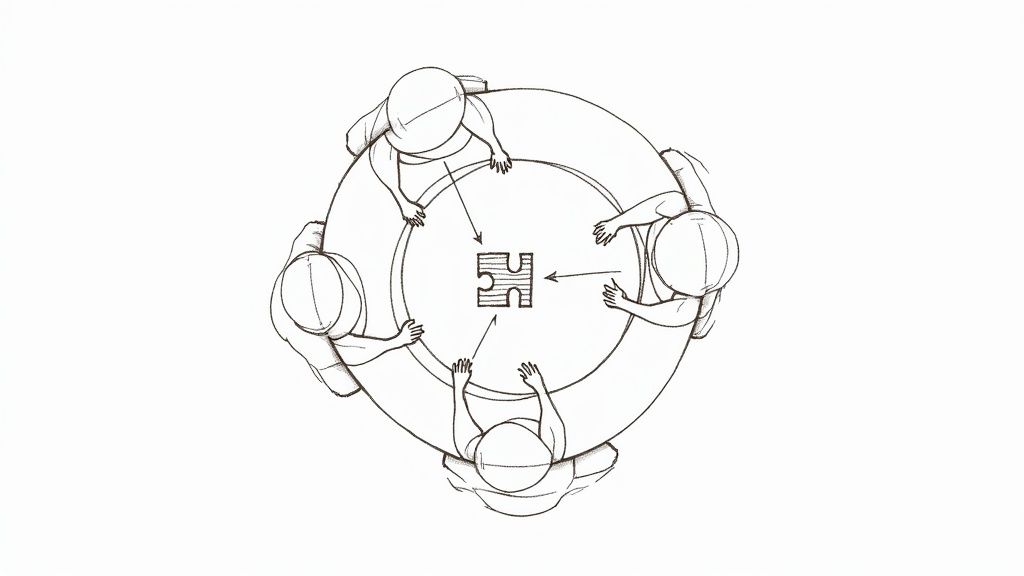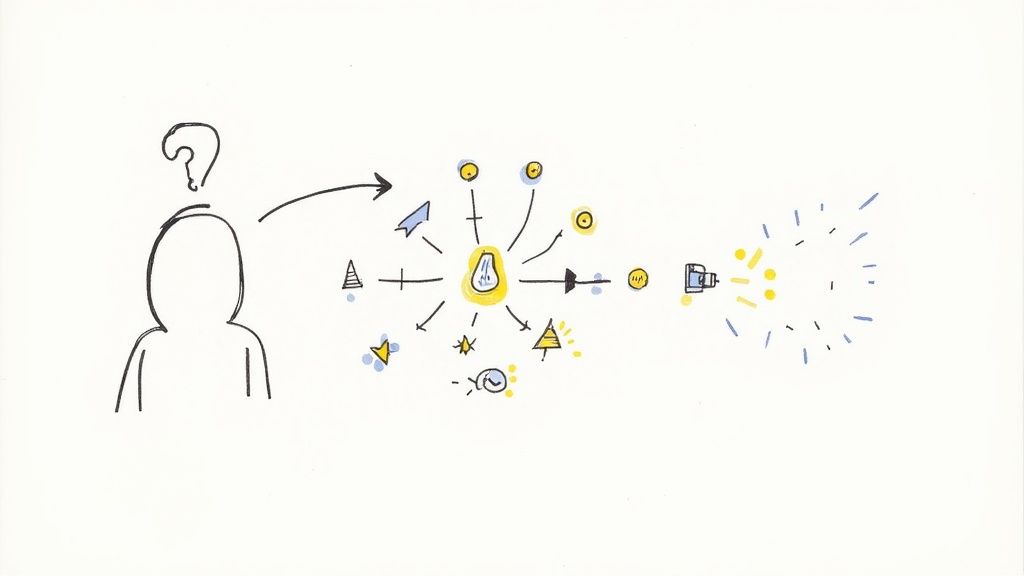
9 Active Learning Strategies to Boost Engagement in 2025
The traditional, passive lecture model is fading. In its place, educators and trainers are embracing dynamic, participatory methods that transform learning from a one-way broadcast into a collaborative experience. This shift is not just a trend; it is a fundamental recognition of how we truly absorb, retain, and apply new knowledge. Active learning strategies put the learner at the center of the experience, requiring them to do more than just listen. They must engage, problem-solve, discuss, and create.
This approach moves beyond simple information delivery to foster genuine comprehension and critical thinking. By actively participating, learners forge stronger neural connections, leading to significantly higher retention rates and the ability to apply concepts in novel situations. For corporate trainers, this means more effective skill development. For marketers, it translates to more memorable brand interactions. For educators, it builds a foundation for lifelong curiosity and inquiry.
This article dives deep into nine powerful active learning strategies that you can implement to dramatically boost engagement, deepen comprehension, and achieve better outcomes. We will explore the 'how' and 'why' behind each method, offering practical steps, real-world scenarios, and specific ways to leverage technology like interactive video to make these strategies even more impactful in your corporate training, educational courses, or marketing content. Forget the passive monologue; it is time to start a dialogue that drives real results. You will leave with a clear roadmap for implementing these proven techniques to transform how your audience learns.
1. Think-Pair-Share
Think-Pair-Share is a classic and highly effective active learning strategy that encourages individual reflection, collaborative discussion, and group sharing. Developed by Professor Frank Lyman at the University of Maryland, this three-step process transforms passive listeners into engaged participants. It works by providing a structured, low-stakes environment for learners to formulate and articulate their ideas before presenting them to a larger audience.
The process is simple yet powerful:
- Think: The instructor poses an open-ended question or problem. Each learner takes a few moments to think silently and independently, gathering their own thoughts and potential answers.
- Pair: Learners pair up with a neighbor to discuss their individual ideas. This phase allows them to practice articulating their thoughts, hear different perspectives, and build upon each other's insights.
- Share: The instructor calls on a few pairs to share their combined ideas or conclusions with the entire group, fostering a richer, more comprehensive discussion.

Why It Works & Practical Tips
This method is incredibly versatile, working equally well in a K-12 classroom discussing reading comprehension as it does at Harvard Medical School, where it's used to analyze complex diagnostic scenarios. The core benefit is its ability to ensure 100% participation; every learner is required to engage with the material, not just the few who typically volunteer.
To implement this strategy effectively:
- Use a Timer: Keep the session moving by setting strict time limits for each phase (e.g., 1 minute to think, 3 minutes to pair).
- Ask Good Questions: Pose thought-provoking, open-ended questions that spark debate and don't have a single right answer.
- Circulate and Listen: During the "Pair" phase, walk around the room to listen in on discussions. This helps you gauge understanding and identify common misconceptions.
- Use Cold Calling: When it’s time to share, randomly select pairs rather than asking for volunteers. This holds everyone accountable and ensures a wider range of ideas are heard.
Mindstamp Use-Case
In a corporate training video, you can simulate Think-Pair-Share using Mindstamp's interactive features. Pause the video with a question and use a Text Response question to prompt the "Think" phase. Then, instruct viewers to discuss their answers with a colleague before the video resumes, effectively creating a virtual "Pair" moment even for asynchronous learners.
2. Peer Instruction
Peer Instruction is an evidence-based, interactive teaching method that transforms the traditional lecture into a dynamic learning environment. Popularized by Harvard Professor Eric Mazur, this strategy centers on asking students conceptual questions, having them commit to an answer individually, and then discussing their reasoning with a neighbor before re-voting. This process makes student thinking visible and leverages peer-to-peer teaching to correct misunderstandings in real time.

The method follows a clear cycle:
- Initial Question & Vote: The instructor poses a carefully designed multiple-choice question that targets a common misconception. Learners reflect and vote individually, often using personal response systems or "clickers."
- Peer Discussion: Learners turn to their neighbors and try to convince them of their answer. This discussion phase is where deep learning occurs as students must articulate their reasoning and confront alternative viewpoints.
- Second Vote & Explanation: After the discussion, learners vote again. The instructor then explains the concept, guided by the results of the two votes and the insights gained from listening to peer discussions.
Why It Works & Practical Tips
This strategy has demonstrated remarkable success, with studies from Harvard University's physics courses showing a twofold improvement in conceptual understanding. Its power lies in moving the focus from passive information transfer to active knowledge construction. Learners are not just receiving information; they are actively grappling with it and teaching one another, which is one of the most effective active learning strategies available.
To implement Peer Instruction effectively:
- Design Great Questions: The success of this method hinges on the quality of your conceptual questions. Focus on targeting common difficulties and create plausible distractors that represent typical errors in thinking.
- Allow Enough Time: Give learners sufficient time for the peer discussion phase, typically 2-3 minutes. This is the core of the activity, so don't rush it.
- Listen, Don't Intervene: During the discussion, circulate the room to listen to students' arguments. This provides invaluable insight into their thought processes and helps you tailor your follow-up explanation.
- Use Data to Guide Instruction: Use the voting results to make informed decisions. If a large majority gets the answer right after the discussion, you can briefly confirm the answer and move on. If confusion persists, a more detailed explanation is needed.
Mindstamp Use-Case
Peer Instruction can be adapted for asynchronous corporate training with Mindstamp. Use a Multiple Choice Question to pose a conceptual problem. After the learner submits their initial answer, reveal the percentage of other viewers who chose each option. Then, use a Text Comment feature to instruct them to "Imagine explaining your reasoning to a colleague who chose the most popular wrong answer" before revealing the correct solution and a detailed video explanation.
3. Problem-Based Learning (PBL)
Problem-Based Learning (PBL) is a student-centered active learning strategy where learning is driven by the process of solving an authentic, ill-structured problem. Unlike traditional instruction where facts are presented first, PBL immerses learners in a real-world scenario from the outset. Working in small collaborative groups, they must identify learning gaps, conduct research, and apply new knowledge to develop a viable solution, with the instructor acting as a facilitator rather than a lecturer.
This powerful approach was pioneered in medical education, most notably at McMaster University Medical School, to better prepare students for clinical practice. The core process typically involves:
- Encountering the Problem: Learners are presented with a complex problem that lacks a clear, single solution.
- Identifying Needs: The group determines what they already know, what they need to find out, and where to find the necessary information or skills.
- Applying Knowledge: Learners collaboratively apply their research and new understanding to propose, test, and refine their solution to the problem.

Why It Works & Practical Tips
PBL excels at developing critical thinking, problem-solving skills, and self-directed learning habits. By grappling with ambiguity and complexity, learners develop a deeper, more contextualized understanding of the subject matter compared to rote memorization. This is why institutions like Harvard Business School rely on its case method, a form of PBL, to train future business leaders.
To implement Problem-Based Learning as one of your core active learning strategies:
- Design Authentic Problems: The problem must be complex, open-ended, and relevant to the learners' world. A well-designed problem is the cornerstone of successful PBL.
- Provide Scaffolding: Initially, guide students on how to conduct research, collaborate effectively, and manage their time. Provide necessary resources without giving away the solution.
- Establish Clear Expectations: Use detailed rubrics to assess both the final product (the solution) and the process (collaboration, research efforts, and critical thinking).
- Act as a Facilitator: Your role is to ask probing questions, redirect efforts when groups are stuck, and guide the learning process, not to provide direct answers.
Mindstamp Use-Case
Simulate a PBL experience in an asynchronous training module using Mindstamp. Start the video by presenting a complex client problem or a technical fault scenario. Use a Comment feature to create a "virtual whiteboard" where learners can post what they know and what they need to find out. Then, use Hotspots to link out to external resources or internal knowledge-base articles where they can conduct their "research" before returning to propose a solution in a final Video Response question.
4. Flipped Classroom
The Flipped Classroom is a powerful active learning strategy that inverts the traditional educational model. Instead of using valuable class time for lectures, foundational content is delivered to learners beforehand, typically through videos or readings. This frees up in-person or synchronous time for what truly matters: interactive, hands-on activities, collaborative problem-solving, and deeper discussions. Popularized by educators like Jonathan Bergmann, Aaron Sams, and Salman Khan of Khan Academy, this model shifts the instructor’s role from a "sage on the stage" to a "guide on the side."
The core idea is to move passive learning activities outside the classroom and reserve face-to-face time for active learning. Learners absorb new information at their own pace and can review complex topics as needed. When they come to class, they are prepared to apply their knowledge, with the instructor present to provide immediate support, clarification, and guidance. This approach makes the classroom a dynamic environment for engagement rather than a passive space for information reception.

Why It Works & Practical Tips
The Flipped Classroom model maximizes the value of instructor-led time. It is highly effective in subjects that require significant problem-solving, like the computer science courses at Stanford or the chemistry classes at the University of North Carolina, which saw notable improvements in student performance. The key benefit is that it provides a differentiated and personalized learning path; learners control the pace of initial instruction, while class time is dedicated to applying concepts in a supportive, collaborative setting.
To implement this strategy effectively:
- Keep Pre-Class Content Concise: Create or curate short, focused videos (ideally 5-10 minutes) that cover a single concept. This respects learners' time and improves retention.
- Ensure Accountability: Embed low-stakes quizzes or short reflection questions with the pre-class materials to ensure learners complete the work and come prepared.
- Design Purposeful Activities: In-class activities must directly build on the pre-class content. They should require higher-order thinking like analysis, application, or creation.
- Provide Technical Support: Ensure all learners can access the materials. Offer clear instructions, support channels, and alternative formats if needed.
Mindstamp Use-Case
The Flipped Classroom is a natural fit for Mindstamp. You can create the entire pre-class lesson within a single interactive video. Use Chapter Markers to break the content into digestible sections. Throughout the video, insert Text or Draw on Video annotations to highlight key formulas or concepts. Most importantly, add a graded Question at the end to serve as the accountability check, ensuring viewers have mastered the material before attending the live session.
5. Collaborative Learning
Collaborative Learning is a powerful educational approach where learners work together in small, structured groups to achieve a shared goal. Unlike simple group work, this strategy emphasizes positive interdependence, meaning group members rely on each other to succeed. Pioneered by researchers like David and Roger Johnson, it transforms learning from a solitary activity into a social and interactive process.
This method involves assigning a task or problem that requires a team effort to solve. Key elements often include:
- Positive Interdependence: The task is structured so that individuals cannot succeed unless the group succeeds.
- Individual Accountability: Each member is responsible for their own learning and for contributing to the group's output.
- Interpersonal Skills: Learners must practice communication, trust-building, and conflict resolution to work effectively.
- Group Processing: Teams reflect on how well they are functioning and identify areas for improvement.
Why It Works & Practical Tips
Collaborative learning moves beyond simple content mastery to build critical thinking, problem-solving, and social-emotional skills. Famous applications include Elliot Aronson’s Jigsaw method, where each student becomes an "expert" on one piece of a topic and teaches it to their group, and Process Oriented Guided Inquiry Learning (POGIL) used in science courses. The strategy promotes deeper understanding as learners must explain concepts to their peers, solidifying their own knowledge in the process.
To implement this active learning strategy successfully:
- Establish Clear Roles: Assign roles like facilitator, recorder, or timekeeper to ensure everyone contributes and the task stays on track.
- Structure the Activity: Design tasks with specific deliverables and clear instructions. Don't just say "work together"; define how they should collaborate.
- Monitor and Intervene: Circulate among the groups to observe dynamics, clarify confusion, and guide teams that are struggling.
- Assess Both Group and Individual: Use a combination of a group grade for the final product and an individual assessment to ensure everyone is accountable for the material.
Mindstamp Use-Case
Simulate collaborative learning in an asynchronous environment by using Mindstamp’s Comment feature. After a video segment presents a complex problem, instruct learners to post their initial solution ideas as a time-stamped comment. Then, require them to reply to at least two peers’ comments with constructive feedback or alternative approaches, fostering a digital collaboration that deepens their collective understanding.
6. Case-Based Learning
Case-Based Learning (CBL) is a powerful active learning strategy that anchors education in the analysis of real-world scenarios. Instead of starting with abstract theories, learners are presented with a detailed, authentic case that requires them to apply knowledge, collaborate, and make decisions to solve a complex problem. This method bridges the gap between theoretical understanding and practical application, fostering deep critical thinking skills.
The process involves presenting learners with a narrative or a set of data describing a situation that has a genuine dilemma or challenge at its core. Learners work, often in small groups, to:
- Analyze: Dissect the case, identify the key issues, and sort through relevant and irrelevant information.
- Discuss: Debate different perspectives, generate potential solutions, and evaluate the pros and cons of each approach.
- Decide: Formulate a justified recommendation or plan of action based on their analysis and evidence from the case.
Why It Works & Practical Tips
Pioneered by institutions like Harvard Business School and widely adopted in medical and scientific education, CBL is one of the most effective active learning strategies for developing higher-order thinking. It excels at teaching learners not just what to think, but how to think like a professional in a given field. The authenticity of the cases makes learning relevant and memorable.
To implement this strategy effectively:
- Select Appropriate Cases: Choose cases that are complex enough to be engaging but not so advanced that they overwhelm learners' current knowledge base.
- Provide Guided Questions: Structure the analysis by providing a set of questions that guide learners through the key aspects of the case, from problem identification to solution evaluation.
- Facilitate a Thorough Debrief: The most crucial phase is the group debrief, where the instructor helps learners connect their specific case conclusions to broader concepts, theories, and principles.
- Encourage Multiple Perspectives: Frame the discussion to show there is often no single "right" answer, emphasizing the importance of a well-reasoned justification for any chosen path.
Mindstamp Use-Case
Mindstamp is ideal for creating immersive, digital case studies. You can build a video that presents the initial case scenario and then pause it to ask a Multiple Choice Question with "What would you do next?" as the prompt. Based on the viewer's choice, you can use Conditional Logic to branch them to a different video segment showing the consequences of their decision. This transforms a passive viewing experience into a dynamic, choice-driven case analysis. To explore how to build these kinds of choice-driven narratives, you can learn more about scenario-based training.
7. Inquiry-Based Learning
Inquiry-Based Learning is a powerful, student-centered approach that shifts the focus from the instructor delivering content to learners constructing their own knowledge. Instead of being given facts to memorize, students are presented with a scenario, question, or problem that sparks their curiosity. This method, heavily influenced by the educational philosophies of John Dewey, emphasizes the process of investigation and discovery as the primary vehicle for learning.
The core of this strategy involves a cyclical process:
- Questioning: Learners formulate their own questions about a topic.
- Investigating: They actively seek out information and data using various resources to answer their questions.
- Creating: Students synthesize their findings to create a solution, explanation, or new understanding.
- Discussing & Reflecting: They share their discoveries with peers and reflect on what they learned and how they learned it.
Why It Works & Practical Tips
This strategy excels at developing critical thinking, problem-solving, and research skills. It transforms learning from a passive reception of information into an active, engaging quest for answers. This approach is highly effective across disciplines, from POGIL (Process Oriented Guided Inquiry Learning) in chemistry labs to the 5E Model (Engage, Explore, Explain, Elaborate, Evaluate) in science education.
To successfully implement Inquiry-Based Learning:
- Start Structured: Begin with "structured inquiry," where you provide the question and a clear method, before gradually moving to "open inquiry," where learners formulate their own questions and investigation plans.
- Provide Scaffolding: Equip learners with the necessary tools and resources. Teach them how to conduct research, evaluate sources, and synthesize information.
- Use Guiding Questions: Act as a facilitator. When learners get stuck, ask probing questions to guide their thinking rather than giving them the answer directly. This is a key component of these active learning strategies.
- Prioritize Reflection: Dedicate time for learners to reflect on their findings and the inquiry process itself. What worked? What challenges did they face? How did their understanding change?
Mindstamp Use-Case
You can design a complete inquiry-based lesson within a single Mindstamp video. Start with a video clip presenting a problem or a puzzling phenomenon. Use a Hotspot question to have viewers identify key variables. Then, link to external articles or embed documents directly in the video for the investigation phase. By using branching logic based on viewer responses, you can create different paths of inquiry, effectively designing personalized learning pathways for each user.
8. Just-in-Time Teaching (JiTT)
Just-in-Time Teaching (JiTT) is a dynamic pedagogical strategy that creates a powerful feedback loop between out-of-class preparation and in-class instruction. Developed by Gregor Novak at Indiana University, JiTT involves students completing brief, web-based assignments before a class session. The instructor then reviews these submissions "just in time" to adjust the upcoming lesson plan, focusing directly on student difficulties, misconceptions, and areas of interest.
This active learning strategy transforms the traditional lecture model into a responsive, learner-centered dialogue. The pre-class work primes students for deeper engagement, while the instructor’s data-driven adjustments ensure that valuable class time is spent addressing the most critical learning gaps.
- Pre-Class Assignment: Students complete short, concept-focused questions or tasks online, typically 24-48 hours before class.
- Instructor Review: The instructor quickly analyzes student responses to identify common themes, correct ideas, and persistent misunderstandings.
- Instructional Adjustment: The classroom session is tailored based on the pre-class data. The instructor can skip what students already know and dedicate time to clarifying difficult concepts or facilitating targeted discussions.
Why It Works & Practical Tips
The core strength of Just-in-Time Teaching is its ability to make classroom time maximally relevant and efficient. It ensures that instruction is directly aligned with demonstrated student needs, not just assumed ones. This method has been successfully implemented across various fields, from its origins in physics at Indiana University to engineering at the Air Force Academy and a wide range of STEM disciplines at George Mason University. It turns passive content absorption into an active, preparatory exercise.
To implement this strategy effectively:
- Keep Assignments Short: Design pre-class tasks to take no more than 15-20 minutes. The goal is to gauge understanding, not to assign extensive homework.
- Prepare Flexible Plans: Based on potential student responses, have two or three possible directions for the class session prepared. This allows you to pivot smoothly based on the data you collect.
- Use Anonymized Responses: Share interesting, insightful, or common incorrect answers with the class anonymously. This validates student effort and creates a safe, low-stakes entry point for discussion.
- Close the Loop: Explicitly state how the pre-class work informed the day's lesson. This shows students that their preparatory effort has a direct impact and is highly valued.
Mindstamp Use-Case
JiTT is perfectly suited for modern corporate training and onboarding. Before a live virtual training session, send learners a short Mindstamp video covering foundational concepts. Embed a few crucial Text Response or Multiple Choice questions to check comprehension. Analyze the response data in your Mindstamp report to identify areas where the team is struggling. You can then start the live session by saying, "I noticed in the pre-work that many of us had questions about X, so let's start there," making the training immediately relevant and responsive.
9. Team-Based Learning (TBL)
Team-Based Learning (TBL) is a structured, collaborative learning strategy that transforms the traditional classroom into a dynamic, team-oriented environment. Developed by Larry Michaelsen at the University of Oklahoma, this comprehensive method uses a specific sequence of individual work, group work, and immediate feedback to enhance student engagement and accountability. In TBL, learners are organized into permanent, strategically formed teams for the duration of a course.
The TBL process follows a consistent cycle:
- Preparation: Students complete pre-class readings or assignments individually to gain foundational knowledge.
- Readiness Assurance: In class, students first take a multiple-choice quiz individually (the iRAT - Individual Readiness Assurance Test). They then take the exact same quiz as a team (the tRAT - Team Readiness Assurance Test), coming to a consensus on each answer.
- Application-Focused Exercises: The majority of class time is spent with teams working together to solve significant, complex problems that require them to apply and deepen their understanding.
Why It Works & Practical Tips
This model is a powerful example of active learning strategies in action, used effectively in demanding fields like the University of Oklahoma College of Medicine and Duke University's Fuqua School of Business. TBL works because it ensures both individual accountability through the iRAT and fosters deep collaborative problem-solving during the tRAT and application exercises. The structure promotes high-level discussion and peer teaching within teams.
To implement TBL successfully:
- Form Diverse Teams: Strategically create permanent teams with a diverse mix of skills and backgrounds. Avoid letting students self-select, as this often leads to imbalanced groups.
- Use the Readiness Assurance Process (RAP): Consistently use the iRAT-tRAT sequence. The immediate feedback and team debate during the tRAT are crucial for correcting misconceptions and solidifying knowledge.
- Design Authentic Application Activities: Create complex problems or case studies that require true teamwork to solve. The best activities do not have a single, simple answer and force teams to make and defend a specific choice.
- Provide Team Dynamics Training: At the beginning of the term, offer guidance on effective communication, conflict resolution, and collaborative decision-making to help teams function smoothly.
Mindstamp Use-Case
You can use Mindstamp to manage the critical Preparation and Readiness Assurance phases of TBL, especially in a hybrid or online setting. Assign pre-class videos containing embedded multiple-choice questions to ensure comprehension. For the iRAT, create a timed Mindstamp quiz that learners must complete individually. You can then use the analytics to identify common areas of confusion before learners even begin their team-based application work.
Active Learning Strategies Comparison Table
Putting Active Learning into Action with Interactive Video
The journey through these nine distinct active learning strategies reveals a powerful, unifying theme: the most effective learning experiences are not passive, they are participatory. From the simple yet profound Think-Pair-Share method to the complex, multi-layered approach of Team-Based Learning, the goal remains the same. We must shift learners from the role of spectator to that of an active participant in their own comprehension and skill development.
These frameworks are not merely academic theories; they are practical blueprints for engagement that translate seamlessly into corporate training, marketing, and sales enablement. The core principles of collaboration, critical thinking, and immediate application are universal drivers of retention and behavior change. Whether your goal is to help a sales team master a new product, onboard new employees more effectively, or capture the attention of a marketing audience, the answer lies in making the experience interactive and learner-centric.
From Theory to Tangible Results
The primary takeaway from this exploration is the need to move beyond one-way information delivery. The era of pressing play and hoping for the best is over. Success in today's digital landscape hinges on creating feedback loops, checking for understanding, and providing opportunities for learners to apply what they've seen.
Consider the practical implications:
- For Corporate Trainers: Instead of a linear training video, you can use a Case-Based Learning model with interactive branching. Learners make decisions at critical points, and the video's narrative adapts, showing them the real-world consequences of their choices.
- For Marketers: A standard product demo can be transformed into an Inquiry-Based Learning experience. Use clickable hotspots and questions to let potential customers explore the features that matter most to them, creating a personalized journey that builds brand affinity.
- For Sales Teams: Implement a Flipped Classroom approach by sending a prospect an interactive video overview before a call. By embedding qualifying questions, you can use Just-in-Time Teaching principles to tailor your live conversation to their specific needs and knowledge gaps, making the interaction far more valuable.
The Power of Interactive Video in Active Learning
The common thread connecting these modern applications is technology, specifically interactive video. Platforms like Mindstamp are not just video players; they are active learning environments. They provide the tools to embed the very mechanisms of these strategies directly into your content. You can insert a question to simulate a Think-Pair-Share prompt, use buttons to create a Problem-Based Learning scenario, or add personalized calls-to-action that guide the user's next step.
This technology makes sophisticated active learning strategies scalable and measurable. You are no longer guessing if your audience is engaged; you have the data to prove it. You can see which questions are challenging, where viewers drop off, and how different segments interact with your content. To truly leverage interactive video for active learning, understanding how to make interactive videos that drive real engagement is paramount. This knowledge allows you to build experiences that are not just interactive for the sake of it, but are strategically designed to foster deeper learning and achieve specific outcomes.
Ultimately, embracing these strategies is about respecting your audience's time and intelligence. It's a commitment to creating more meaningful, memorable, and impactful connections. The future of digital communication isn't just watching; it's doing. Your next step is to choose one strategy from this list, identify a piece of content, and begin transforming it from a monologue into a dialogue.
Ready to turn passive viewers into active learners? Mindstamp makes it easy to add questions, buttons, branching logic, and more to any video, bringing these powerful active learning strategies to life. Start your free trial today and discover how interactive video can transform your training, marketing, and sales content.
Get Started Now
Mindstamp is easy to use, incredibly capable, and supported by an amazing team. Join us!



Try Mindstamp Free










